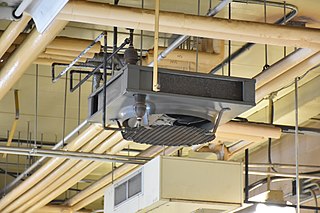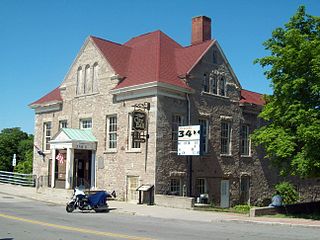
A boiler is a closed vessel in which fluid is heated. The fluid does not necessarily boil. The heated or vaporized fluid exits the boiler for use in various processes or heating applications, including water heating, central heating, boiler-based power generation, cooking, and sanitation.

Lockport is both a city and the town that surrounds it in Niagara County, New York, United States. The city is the Niagara county seat, with a population of 21,165 according to 2010 census figures, and an estimated population of 20,305 as of 2019.

Cogeneration or combined heat and power (CHP) is the use of a heat engine or power station to generate electricity and useful heat at the same time.

A central heating system provides warmth to a number of spaces within a building from one main source of heat. It is a component of heating, ventilation, and air conditioning systems, which can both cool and warm interior spaces.

Birdsill Holly Jr. was an American mechanical engineer and inventor of water hydraulics devices. He is known for inventing mechanical devices that improved city water systems and patented an improved fire hydrant that is similar to those used currently for firefighting. Holly was a co-inventor of the Silsby steam fire engine. He founded the Holly Manufacturing Company that developed into the larger Holly Steam Combination Company that distributed heat from a central station and developed commercial district heating for cities in the United States and Canada.

District heating is a system for distributing heat generated in a centralized location through a system of insulated pipes for residential and commercial heating requirements such as space heating and water heating. The heat is often obtained from a cogeneration plant burning fossil fuels or biomass, but heat-only boiler stations, geothermal heating, heat pumps and central solar heating are also used, as well as heat waste from factories and nuclear power electricity generation. District heating plants can provide higher efficiencies and better pollution control than localized boilers. According to some research, district heating with combined heat and power (CHPDH) is the cheapest method of cutting carbon emissions, and has one of the lowest carbon footprints of all fossil generation plants.

Hydronics is the use of liquid water or gaseous water (steam) or a water solution as heat-transfer medium in heating and cooling systems. The name differentiates such systems from oil and refrigerant systems.

James Howden was a Scottish engineer and inventor who is noted for his invention of the Howden forced draught system for steam boilers.
Condensing boilers are water heaters typically used for heating systems that are fueled by gas or oil. When operated in the correct circumstances, a heating system can achieve high efficiency by condensing water vapour found in the exhaust gases in a heat exchanger to preheat the circulating water. This recovers the latent heat of vaporisation, which would otherwise have been wasted. The condensate is sent to a drain. In many countries, the use of condensing boilers is compulsory or encouraged with financial incentives.
David N. Crosthwait Jr. was an African-American mechanical and electrical engineer, inventor, and writer. Crosthwait's expertise was on air ventilation, central air conditioning, and heat transfer systems. He was responsible for creating heating systems for larger buildings such as Rockefeller Center and New York's Radio City Music Hall. He was granted an honorary doctoral degree in 1975 from Purdue University. In 1971, Crosthwait was elected as a fellow of the American Society of Heating, Refrigeration, and Air Conditioning Engineers (ASHRAE), making him the first African American fellow. Crosthwait was also named a fellow of the American Association for the Advancement of Science (AAAS).

The New York City steam systems include Con Edison's Steam Operations, and other smaller systems that provide steam to New York University and Columbia University. Many individual buildings in New York have their own steam systems.
Creative Energy is a private district heating company. The company was founded on November 1, 1968, by group of engineers with a desire to lower heating bills for buildings and to reduce the amount of pollution being created to provide heat downtown. In 2014, Central Heat Distribution was rebranded as Creative Energy and began taking on additional district heating projects in Vancouver and Toronto.

An electric steam boiler is a type of boiler where the steam is generated using electricity, rather than through the combustion of a fuel source. Such boilers are used to generate steam for process purposes in many locations, for example laundries, food processing factories and hospitals. Although they are more expensive to run than gas-fired or oil-fired boilers they are popular because of their simplicity and ease of use. Because of the large currents required, they are normally run from a three-phase electricity supply. They convert electrical energy into thermal energy with almost 100% efficiency but the overall thermal efficiency is variable, depending on the efficiency with which the electricity is generated.

The Willis Avenue Station is a steam production plant used in Detroit's district steam heating system. The plant is located at 50 West Willis Street, near Woodward Avenue, in the center of the city's Midtown Detroit neighborhood. Built and owned by the Detroit Edison Company, it was listed on the National Register of Historic Places in 1997.

Steam is a substance containing water in the gas phase, and sometimes also an aerosol of liquid water droplets, or air. This may occur due to evaporation or due to boiling, where heat is applied until water reaches the enthalpy of vaporization. Steam that is saturated or superheated is invisible; however, wet steam or water vapor, a visible mist or aerosol of water droplets, is often referred to as "steam".

Radiators and convectors are heat exchangers designed to transfer thermal energy from one medium to another for the purpose of space heating.
The Still engine was a piston engine that simultaneously used both steam power from an external boiler, and internal combustion from gasoline or diesel, in the same unit. The waste heat from the cylinder and internal combustion exhaust was directed to the steam boiler, resulting in claimed fuel savings of up to 10%.

Benjamin C. Moore Mill is a historic flour mill, waterworks, and city hall building located at Lockport in Niagara County, New York. It is a stone structure built in 1859–60, as a flour mill for the Benjamin C. Moore Company. In 1864, Dwight Keep constructed this stone structure that was originally the Benjamin Moore Company Mill. Around 1884, it was converted from a flour mill, to one of the first water pumping plants in America. Within the basement of the Moore building, two of Birdsill Holly's pumps were installed, one pushing 3 million gallons of water and the other pushing 5 million, each utilizing the waterpower from the Mill Race. In 1893, the rear addition was constructed and the building was converted for use as city hall for the City of Lockport and was used as city hall until 1974, when the new city hall opened. It was listed on the National Register of Historic Places in 1973.

The Excelsior Power Company Building is a residential building at 33–43 Gold Street in the Financial District of Manhattan in New York City. It was designed in the Romanesque Revival style by William C. Gunnell and built by Robert L. Darragh. Completed in 1889, it is Manhattan's oldest known remaining building erected specifically for commercial power generation.


















